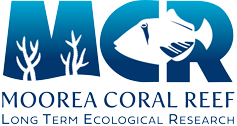Year:
2024
Authors:
Source:
M.S. Thesis
Abstract:
Global climate change is not only the greatest threat to coral reefs, but also affects these tropical systems disproportionately, as shallow coastal environments tend to acidify and warm much faster than the open-ocean. Ocean acidification (OA) hinders the calcification of dominant reef builders, such as crustose coralline algae (CCA), and the concurrently warming ocean waters will likely exacerbate this OA perturbation effect. Natural heterogeneity of the physical reef environment may also impose additional stress on these sessile calcifiers, as CCA already experiencing high-frequency variability in seawater pH and temperature may not be able to tolerate further environmental changes that worsen any adverse effects. Because OA and warming are expected to intensify under climate change, and the scale and frequency of environmental variation is also expected to increase, I evaluated the interactive effects of variable seawater pH and temperature on the physiology of a dominant tropical coralline, Lithophyllum kotschyanum, in Moorea, French Polynesia. A 6-week field experiment demonstrated that L. kotschyanum photosynthesis declined in back reef environments with greater in situ variability, whereas calcification and respiration were unaffected by environmental differences. Net photosynthesis was 34% lower for algae in the downstream habitats where pH and temperature of seawater fluctuated at larger daily magnitudes of about 0.05 pH and 0.5 °C, respectively, than in upstream habitats. Net calcification and respiration also showed declined rates in downstream L. kotschyanum populations, although these trends were not statistically significant. The immediate photosynthetic response compared to calcification and respiration responses during this field study suggests CCA photosynthesis may be more sensitive to changes that amplify diel seawater variability occurring on reefs today. A subsequent 2-week mesocosm study was conducted to tease apart the direct effects of diel pH and temperature variation on L. kotschyanum physiology by crossing two pH treatments (constant = 8.0; fluctuating = 7.9-8.05) with two temperature treatments (constant = 28 °C; fluctuating = 27-29 °C) representing ambient conditions of their natural reef habitat. L. kotschyanum net photosynthesis significantly increased in treatments where temperature was fluctuating, but reduced only slightly when pH was fluctuating. The insignificant effect of pH fluctuations on photosynthesis, however, was likely owed to the logistical constraint of the pH treatments having similar daytime pH values. Respiration was not affected directly by pH or temperature treatments and instead followed a similar trend as photosynthesis to the mesocosm treatments. This respiration response corroborates that CCA respiration may be more influenced by internal photosynthetic activity rather than changes in external seawater conditions. There was a significant interaction between temperature and pH treatments on L. kotschyanum calcification, which may result from the novel regime of fluctuating seawater treatments. Isolated temperature and pH fluctuations both reduced net calcification, whereas their combined fluctuations did not decrease rates as drastically. This mitigating effect may be explained by the way CCA calcification responds to paralleled changes of pH and temperature in a diel period. Daily pH minima is a key driver for reduced net calcification with greater pH variability due to lower nocturnal pH enhancing dissolution activity. Thus, temperature and pH simultaneously declining at night may have resulted in cooler temperatures that slowed these dissolution rates. This mitigating response to coinciding pH and temperature fluctuations may also explain the lack of a calcification response to their combined effects during the field study, as the higher daytime pH values that often stimulate CCA calcification may be further enhanced by the warmer daytime temperatures. The results from these collective studies highlight the vulnerability of key reef builders to changes in environmental heterogeneity, particularly the susceptibility of CCA photosynthesis and calcification to amplified diel temperature and pH variability. Moreover, this thesis demonstrated that interactions between fluctuating seawater parameters can be different from interactions when the parameters are held constant, and further corroborates the importance of considering natural variability when assessing organismal responses to environmental changes.
Publication Type:
Thesis or Dissertation
Publisher:
Department of Biology, CSU Northridge



